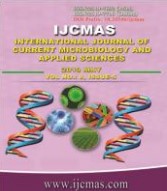


 National Academy of Agricultural Sciences (NAAS)
National Academy of Agricultural Sciences (NAAS)

|
PRINT ISSN : 2319-7692
Online ISSN : 2319-7706 Issues : 12 per year Publisher : Excellent Publishers Email : editorijcmas@gmail.com / submit@ijcmas.com Editor-in-chief: Dr.M.Prakash Index Copernicus ICV 2018: 95.39 NAAS RATING 2020: 5.38 |
A field experiment was conducted during spring 2009-2010 in a Aquic hapludoll at the Norman E. Borlaug Crop Research Centre of the G.B. Pant University of Agriculture and Technology, Pantnagar (290 N latitude and 79 0 29’ E longitude), as per technical programme of All India Coordinated Research Project on the soil test crop response correlation. The experiment was conducted in “two-phases”. In the first phase soil fertility gradient was developed by dividing the experimental field into “three strips” and applying graded doses of fertilizers in them (Strip I no fertilizer), Strip II (100, 100 and 100 kg/ha N, P2O5 and K2O/ha) respectively, and strip III (200, 200 and 200 kg N, P2O5 and K2O) respectively and growing of exhaust crop Oat (Var. Kent). In the second phase, i.e. next season test crop Cowpea (var. Pant lobia-1) was grown by dividing each strip into twenty-four plots having twenty-three fertilizer treatments and one control plot. Response to “select” combinations of “three-levels” of FYM (0, 5 and 10 t/ha), “four-levels” of nitrogen (0, 15, 30 and 45 kg/ha), four levels of phosphorus (0, 30, 60 and 90 kg/ha) and four levels of potassium (0, 30, 60 and 90 kg/ha) at different fertility levels of cowpea was studied. The values of the organic carbon, Alkaline KMnO4 extractable N, Olsen’s P and neutral normal Ammonium Acetate extractable K in the experimental field ranged between 0.72-1.16 per cent, 112.30-200.60 kg/ha, 13.00-24.24 kg/ha and 101.90-245.30 kg/ha, respectively. In the present investigation the total straw yield ranged from 13.07-24.94 q/ha and total grain yield ranged from 9.00-18.20 q/ha. The nutrient requirement for production of one quintal of cowpea grain was found to be 5.71 kg of nitrogen, 0.90 kg of phosphorus and 3.72 kg of potassium. Per cent contribution of nitrogen, phosphorus and potassium was 62.00, 59.00 and 32.00 from soil, whereas from other sources as FYM was 7.00, 29.00, 10.00; chemical fertilizer 30.00, 14.00 and 30.00 and conjoint use of chemical fertilizer with FYM 30.00, 17.00 and 27.00 in terms of NPK respectively. With the help of these data fertilizer recommendation at different yield targets and soil test value can be calculated. Coefficient of quadratic multiple regression (R2) was found highly significant (0.898**) between grain yield, soil test values, added fertilizers and FYM. Organic carbon, alkaline KMnO4-N, Olsen’s-P and AB DTPA and Ammonium acetate K and AB DTPA K methods of available N, P and K respectively were at par for the cowpea grown in Mollisol of Uttarakhand.
 |
 |
 |
 |
 |